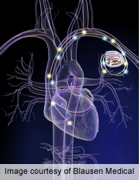
WEDNESDAY, Sept. 4 (HealthDay News) — A new way of implanting pacemakers cuts radiation exposure for doctors and patients, German researchers report.
Using electromagnetic tracking — which works something like GPS navigation — rather than traditional radiation-based imaging may be a safer, faster way to implant cardiac resynchronization therapy (CRT) pacemakers, the scientists explained.
“This is a novel technology that has been shown to enable navigation of devices on pre-recorded X-ray images, which allows the physician to reduce the duration of live X-ray during a procedure,” said lead researcher Dr. Sergio Richter, a consulting electrophysiologist and senior physician at the Heart Center of the University of Leipzig.
The ability to use pre-recorded X-ray images — instead of live X-ray — during a cardiac implant procedure reduces exposure to potentially harmful radiation, he explained.
“This new technology has the potential to revolutionize the way we image inside the body while we perform a wide range of diagnostic and therapeutic interventions in the future,” Richter added.
The report was published Sept. 3 in Circulation: Arrhythmia and Electrophysiology, and funded by St. Jude Medical Inc., the maker of the new MediGuide system.
CRT implantation, which paces both the left and right ventricles, is becoming more common for patients with severe congestive heart failure and other heart problems, the researchers noted.
“Currently, to view and manipulate the different tools that enable implantation of the left-sided lead in the patient’s heart veins, physicians are forced to continuously use live X-ray imaging, exposing patients and themselves to potentially harmful amounts of X-ray,” Richter said. “CRTs are implanted near the chest, and help the heart chambers beat more synchronously together and to pump blood more efficiently.”
Electrical lead wires extend from the device to the patient’s heart chambers, and these leads provide electrical stimulation to the right and left sides of the heart so that the two sides beat together, pumping blood to the rest of the body more easily, he explained.
The MediGuide system uses 3-D imaging to precisely navigate the catheter. “MediGuide, with the use of pre-recorded X-ray images, creates a real-time clinical environment that adjusts automatically for heart rate, respiratory motion and patient motion, and accurately tracks catheter position,” Richter noted.
The average amount of time of X-ray exposure needed to implant a CRT is often more than 20 minutes. With the new tracking system, X-ray exposure averages just five minutes, the researchers found.
“It is well known that increased radiation exposure can be very harmful to the patient, the physician and the staff, increasing the risk of developing various types of cancer,” Richter said.
For the study, Richter’s team used the new tracking system in 15 heart failure patients. In the procedure, X-ray imaging was used for the two device leads on the right side of the heart and the new tracking system was used to place the third lead, on the heart’s left ventricle.
One expert said he saw great potential for other uses for the technology.
“The study provides a glimpse into the future of biventricular device implantation,” said Dr. Neil Sanghvi, a clinical electrophysiologist at Lenox Hill Hospital in New York City. “However, larger studies are needed to confirm the findings,” he added.
“I envision this technology being extended to additional cardiac procedures in the future, including coronary stent implantation as well as valve implantation,” Sanghvi said. “Both patients and surgeons alike will welcome technology to reduce radiation exposure as we continue to learn the ill effects of repetitive radiation exposure.”
More information
For more on pacemakers, visit the U.S. National Heart, Lung, and Blood Institute.
Copyright © 2025 HealthDay. All rights reserved.

